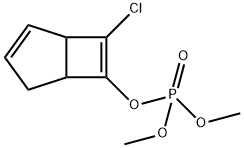Description
Heptenophos is a light brown liquid or crystalline mass. It is soluble
in water (2.2 g/L at 20 ?C) and miscible with most organic
solvents, except aliphatic hydrocarbons. Log Kow = 2.32.
Heptenophos is hydrolyzed in acidic and alkaline media.
Chemical Properties
Pale amber liquid; miscible in most organic solvents; soluble in xylene, acetone, and methanol.
Uses
Heptenophos is a pesticide used for fruits and vegetables.
Uses
Heptenophos is used to control sucking pests (primarily aphids) in
a wide range of crops. It is also used as an ectoparasiticide to control ticks,
lice, mites and fleas in farm animals and pets.
Definition
A nonpersistent contact and systematic phosphate insecticide.
Hazard
Poison; moderately toxic.
Metabolic pathway
Metabolism of heptenophos in soils is by hydrolysis to 7-chloro-bicyclo[3.2.0]hept-2-en-6-one, further transformations of which involve
microbially-mediated Baeyer-Villiger oxidations of the cyclobutanone
moiety, ring opening of the resultant lactones, dechlorination and
dehydrochlorination followed by ultimate mineralisation to CO2 and conversion to unextractable soil-bound residues. In rats, 7-chlorobicyclo[3.2.0]hept-2-en-6-one is further transformed to give the Favorskiirearranged product bicyclo[3.l.0]hex-2-en-6-exo-carboxylic acid as a
urinary metabolite.
Metabolism
In rats 90% of heptenophos is
excreted in the urine and 6% in the feces as water-soluble
metabolites within 6 days after oral administration. In
plant (lettuce), it is completely transformed to watersoluble
metabolites without accumulation within 4 d. In
soil, it is rapidly degraded bymicroorganisms, DT
50 (20 ?C)
being less than 4 h.
Degradation
Heptenophos is hydrolysed in acidic and alkaline media (PM).
Toxicity evaluation
Acute oral LD
50 for rats is
96–121 mg/kg. Inhalation LC50 (4 h) for rats is 0.95 mg/L
air. NOEL (2 yr) for rats is 15 mg/kg diet (0.75 mg/kg/d).
ADI is 3 μg/kg b.w.


